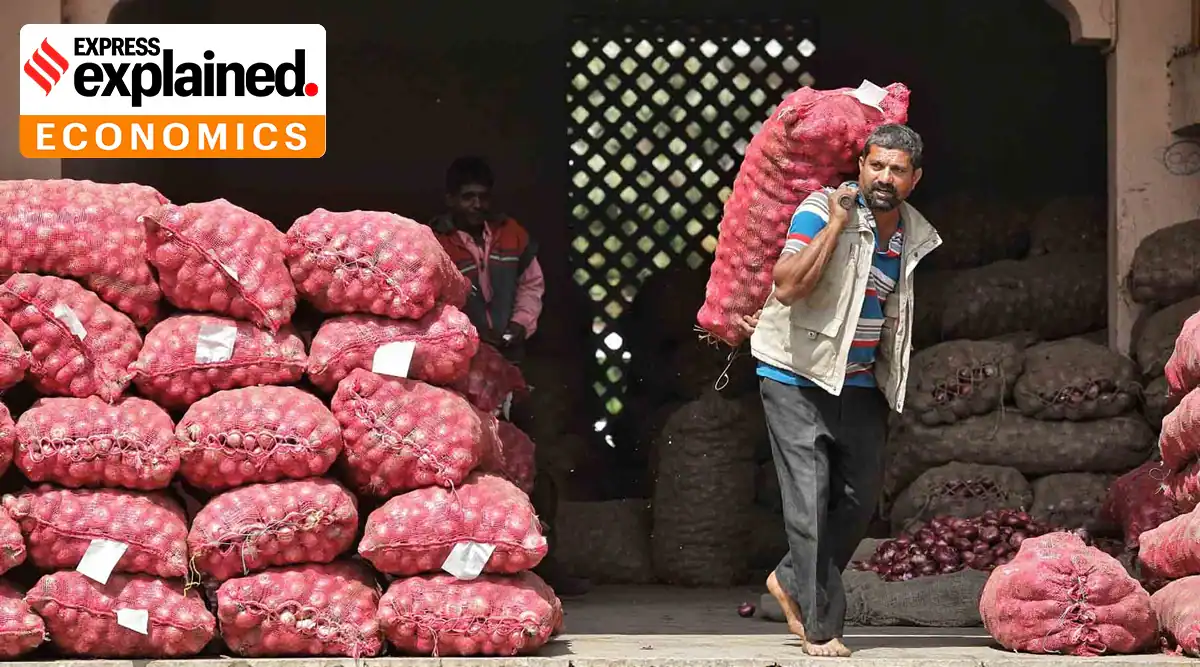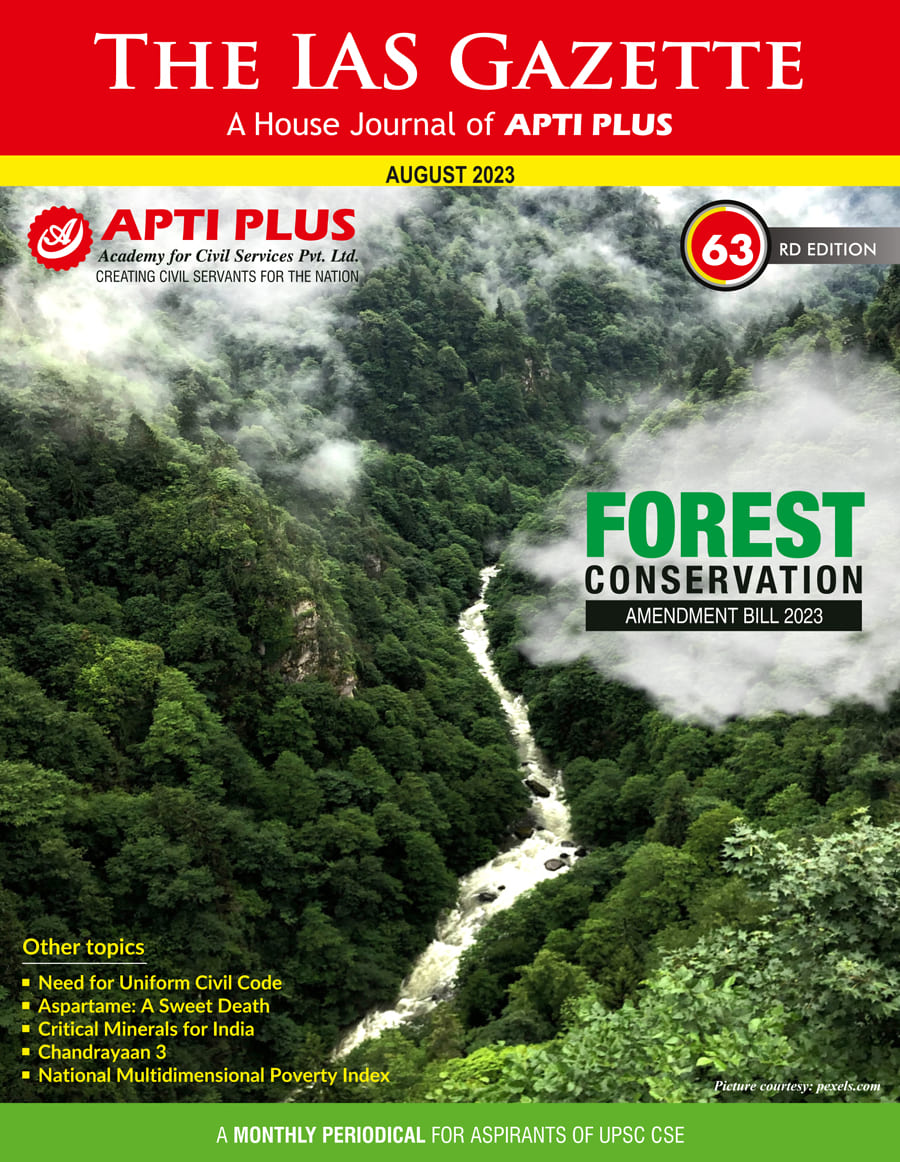
Copyright infringement not intended
Picture Courtesy: The Indian Express
Context: The recent surge in onion prices in India has raised alarm among the central government. As a response to this concern, the Ministry of Finance has taken a significant step by imposing a 40% export duty on onions. This move has resulted in the suspension of onion auctions in Nashik district, Maharashtra, a major onion-producing region in the country.
Details
- The decision to impose an export duty on onions is aimed at stabilizing domestic onion prices by curbing exports. By imposing this duty, the government intends to ensure an adequate supply of onions within the country, which in turn would help in maintaining reasonable prices and preventing further price escalation.
- The fluctuation in onion prices is a significant concern in India, as onions are a staple vegetable and an essential ingredient in many Indian dishes. Price spikes can have a direct impact on household budgets and consumer inflation. Therefore, the central government's decision to impose an export duty reflects its commitment to managing the onion market and ensuring stable prices for consumers.
- The broader implications of this decision include maintaining food security, preventing market manipulation, and safeguarding the interests of both consumers and onion growers. However, it's important to note that while export duties can help control domestic prices, they can also impact the income of farmers who rely on export markets for their produce.

Causes of Rising Onion Prices
Shortage in Stored Produce
- The recent surge in onion prices can be primarily attributed to a scarcity of stored onion produce. Onions are usually harvested in two seasons: Kharif and Rabi. The Kharif crop is harvested in October-November and the Rabi crop is harvested in March-April.
- The Rabi crop accounts for about 60% of the total onion production and is stored for use throughout the year. However, due to unfavourable weather conditions and crop damage, the Rabi crop was lower than expected this year. This resulted in a shortage of stored onions and a higher demand than supply.
Seasonal Nature of Onion Cultivation
- Onions are not cultivated throughout the year like some other vegetables. Farmers usually harvest three crops of onions, with the last crop intended to cater to the market for an extended period. These three crops—Rabi, Kharif, and late Kharif—follow specific sowing and harvesting periods. Among them, the Rabi crop, sown between December and January and harvested after March, is particularly suitable for storage due to its lower moisture content.
Unseasonal Rain and Hailstorm
- Unpredictable weather events, such as unseasonal rain and hailstorms during the Rabi crop season, have significantly impacted onion crops, especially in key onion-producing states like Maharashtra. Hailstorms that occurred in March had a detrimental effect on around 40% of onion crops in certain areas. This damage led to approximately 20% of the crops being deemed unfit for sale due to quality concerns.
Reduced Cultivation
- Another factor that has contributed to the onion crisis is the lower area under cultivation. Many farmers have opted to grow other crops instead of onions due to various reasons such as weather issues, crop damage, low returns, and high input costs. This has led to a decline in onion production and a further gap between demand and supply.

Impact of Rising Onion Prices
- Consumer Burden: Onions are a fundamental ingredient in Indian cooking, and their price increase can significantly impact household budgets, especially for lower-income families who allocate a significant portion of their income to food expenses. The higher cost of onions can lead to changes in consumption patterns and dietary choices.
- Food Inflation: Onions are a staple food item, and their prices can influence the overall inflation rate in the country. When onion prices rise, it can create a ripple effect by increasing the cost of other food items as well, leading to broader food inflation and affecting the purchasing power of consumers.
- Political Sensitivity: Onion price hikes have historically sparked public outrage and protests. The affordability and availability of onions are often symbolic of a government's ability to manage necessities. As a result, governments may face criticism and political challenges, potentially impacting their popularity and credibility.
- Economic Disruption: High onion prices can disrupt supply chains and impact related industries. Food processing, restaurant, and catering businesses that heavily rely on onions as an ingredient can face increased production costs, potentially leading to reduced profitability and adjustments in pricing.
- Social Equity: Lower-income households spend a larger proportion of their income on food. When onion prices rise, these households are disproportionately affected, as they have less flexibility to absorb the increased costs. This can exacerbate inequalities and widen the gap between different socioeconomic groups.
These impacts highlight the interconnectedness of the economy and society, where changes in the price of a single commodity like onions can have widespread effects on consumers, businesses, and political dynamics. Addressing these impacts requires a multi-faceted approach that considers both short-term measures to stabilize prices and long-term strategies to enhance agricultural resilience and supply chain efficiency.
Challenges associated with the onion market
Weather Vulnerability
- Onion cultivation heavily relies on weather conditions. Adverse weather events like unseasonal rain, hailstorms, and droughts can damage crops, leading to reduced supply and price fluctuations. Climate change can exacerbate these challenges, making onion cultivation even more vulnerable to unpredictable weather patterns.
Storage Infrastructure
- Proper storage is crucial for stabilizing onion prices. Without adequate storage facilities, onions cannot be stored effectively after harvest, leading to wastage and supply instability. Investing in modern storage infrastructure, such as cold storage facilities, can help mitigate price volatility caused by seasonal fluctuations in supply.
Supply-Demand Dynamics
- The cultivation of onions and consumer demand do not always align perfectly, resulting in supply-demand imbalances. Sudden changes in cultivation practices or unexpected increases in demand can lead to price spikes. Creating mechanisms to better predict demand and incentivize farmers to adjust cultivation practices accordingly can help manage these dynamics.
Export Dynamics
- While exporting onions can be economically beneficial, it must be managed carefully to ensure domestic stability. High demand from international markets can lead to shortages and price increases in the domestic market. Balancing the needs of both domestic consumers and international customers is a complex challenge that requires effective supply chain management.
Subsidy Distribution
- Subsidies are often implemented to support farmers and stabilize prices. However, challenges in the efficient distribution of subsidies, including administrative delays and corruption, can limit their effectiveness. Streamlining subsidy distribution mechanisms and ensuring transparency can help ensure that the intended benefits reach the farmers who need them.
Addressing these challenges requires a combination of short-term measures and long-term strategies. Short-term measures may involve managing stockpiles, implementing price stabilization mechanisms, and timely subsidy disbursement. Long-term strategies include investing in storage infrastructure, promoting climate-resilient agricultural practices, and improving supply chain coordination to minimize the impact of these challenges on onion prices and availability.
Way Forward
- Storage Enhancement: Investing in modern storage facilities, such as cold storage, can extend the shelf life of onions and prevent spoilage. This will help stabilize prices by ensuring a steady supply even during periods of low cultivation.
- Crop Diversification: Encouraging farmers to diversify their crops can reduce dependence on onions and buffer against price shocks. Promoting the cultivation of other vegetables can provide alternatives for consumers and stabilize the market.
- Resilient Varieties: Developing and promoting onion varieties that are resilient to adverse weather conditions can minimize the impact of weather-related disruptions on onion supply and prices.
- Efficient Subsidy Delivery: Implementing efficient and transparent subsidy distribution mechanisms ensures that financial support reaches farmers in a timely manner. This can help stabilize their income and incentivize onion cultivation.
- Market Intelligence: Establishing real-time market information systems allows policymakers to monitor onion prices, supply, and demand trends. This information can aid in making informed decisions to manage price fluctuations effectively.
- Balanced Trade: Carefully managing onion exports to balance international demand and domestic supply is crucial. Export restrictions during times of domestic scarcity can help maintain price stability at home.
- Climate Resilience: Promoting climate-smart agricultural practices, such as water-efficient irrigation and soil management techniques, can enhance the resilience of onion crops to changing weather patterns and minimize crop losses.

Conclusion
- The surge in onion prices in India is attributed to a shortage in stored produce and lower cultivation due to adverse weather and Rabi crop damage. Addressing the challenges of rising onion prices requires a holistic approach involving storage improvements, crop diversification, resilient farming practices, efficient subsidy distribution, and trade management. Collaborative efforts by the government, farmers, and stakeholders are vital for ensuring price stability, food security, and consumer well-being.
Must Read Articles:
Inflation: https://www.iasgyan.in/daily-current-affairs/inflation-19#:~:text=Inflation%20measures%20the%20average%20price,items%20is%20called%20%27deflation%27.
WHOLESALE INFLATION: https://www.iasgyan.in/daily-current-affairs/wholesale-inflation
|
PRACTICE QUESTION
Q. How does the recent decision to implement a 40% export duty on onions reflect efforts to manage domestic supply and stabilize prices? What are the potential impacts of the rising onion prices on both local consumers and international markets? In light of these developments, what challenges might arise, and what strategies could be explored to address these challenges and chart a sustainable path forward for the onion market?
|
https://indianexpress.com/article/explained/explained-economics/why-onion-prices-are-high-8902630/#:~:text=The%20present%20price%20rise%20has,not%20grown%20around%20the%20year.














